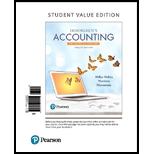
Concept explainers
a) Times interest earned: The times interest earned ratio calculates the ability of a company to pay off its debts. It is also called as interest coverage ratio.
To calculate: The times interest earned ratio
b) Debt to equity ratio: It is a ratio that indicates the soundness of long-term financial policies of a company. It also measures company’s financial leverage.
To calculate: The Debt to equity ratio
c) Earnings per share: It calculates the net income earned by the company per outstanding share.
To calculate: Earnings per share
d) Price Earnings Ratio: The price earnings ratio compares company’s stock price to its earnings per share.
To calculate: The Price Earnings Ratio
e)
To calculate: The Rate of Return on Common Stock
Trending nowThis is a popular solution!

Chapter 14 Solutions
Horngren's Accounting, The Financial Chapters, Student Value Edition Plus MyLab Accounting with Pearson eText - Access Card Package (12th Edition)
- Accurate Answerarrow_forwardWhat is the final selling price to the consumer of this financial accounting question?arrow_forwardA company uses the FIFO method for inventory costing. At the start of the period the production department had 36,000 units in beginning Work in Process inventory which was 48% complete; the department completed and transferred 173,000 units. At the end of the period, 30,000 units were in the ending Work in Process inventory and are 75% complete. The production department had labor costs in the beginning goods in process inventory of $107,000 and total labor costs added during the period are $727,150. Compute the equivalent cost per unit for labor.arrow_forward
- Get correct solution this general accounting questionarrow_forwardMC Company made sales to two customers. Both sales were on credit terms of 2/10, n/30. Customer A purchased $30,000 of goods, returned none, and paid in 9 days. Customer B purchased $40,000 of goods, returned, and was given credit for $4,000 of goods and paid in 25 days. What was the net revenue from these two customers?a. $70,000 b. $66,000 c. $65,400 answerarrow_forwardCompute the manufacturing overhead rate for the yeararrow_forward

 AccountingAccountingISBN:9781337272094Author:WARREN, Carl S., Reeve, James M., Duchac, Jonathan E.Publisher:Cengage Learning,
AccountingAccountingISBN:9781337272094Author:WARREN, Carl S., Reeve, James M., Duchac, Jonathan E.Publisher:Cengage Learning, Accounting Information SystemsAccountingISBN:9781337619202Author:Hall, James A.Publisher:Cengage Learning,
Accounting Information SystemsAccountingISBN:9781337619202Author:Hall, James A.Publisher:Cengage Learning, Horngren's Cost Accounting: A Managerial Emphasis...AccountingISBN:9780134475585Author:Srikant M. Datar, Madhav V. RajanPublisher:PEARSON
Horngren's Cost Accounting: A Managerial Emphasis...AccountingISBN:9780134475585Author:Srikant M. Datar, Madhav V. RajanPublisher:PEARSON Intermediate AccountingAccountingISBN:9781259722660Author:J. David Spiceland, Mark W. Nelson, Wayne M ThomasPublisher:McGraw-Hill Education
Intermediate AccountingAccountingISBN:9781259722660Author:J. David Spiceland, Mark W. Nelson, Wayne M ThomasPublisher:McGraw-Hill Education Financial and Managerial AccountingAccountingISBN:9781259726705Author:John J Wild, Ken W. Shaw, Barbara Chiappetta Fundamental Accounting PrinciplesPublisher:McGraw-Hill Education
Financial and Managerial AccountingAccountingISBN:9781259726705Author:John J Wild, Ken W. Shaw, Barbara Chiappetta Fundamental Accounting PrinciplesPublisher:McGraw-Hill Education





